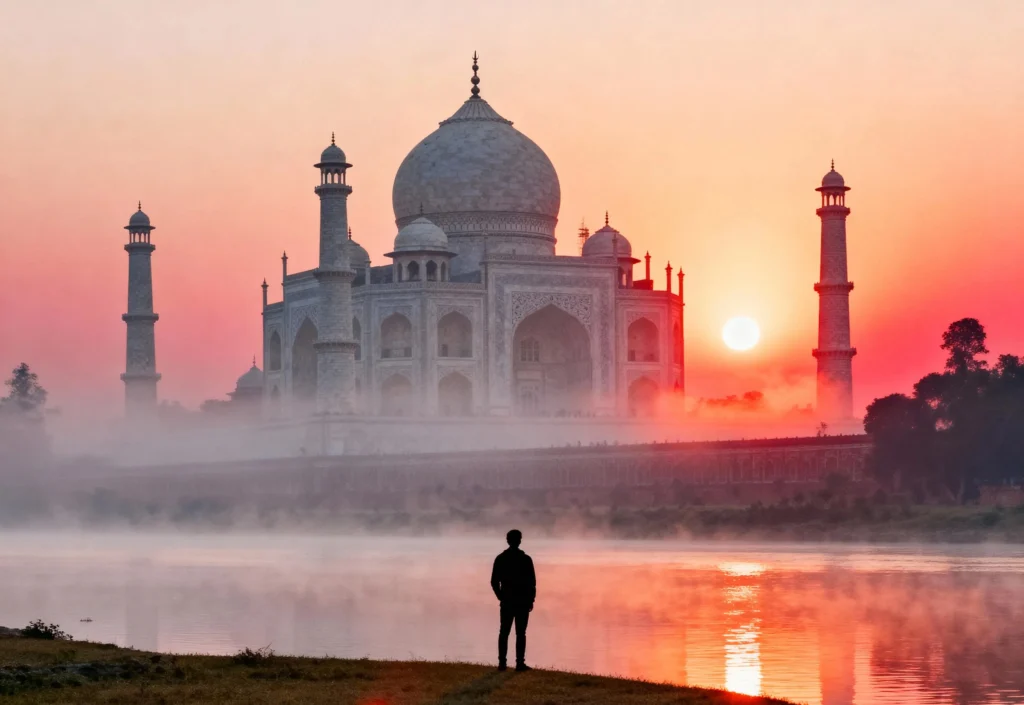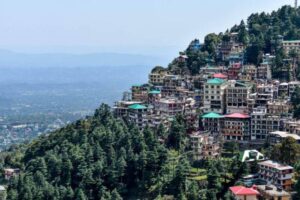There are few moments in life that leave an indelible mark on your soul. Watching the sun rise over the Taj Mahal is one of them. As the first rays of light kiss the white marble, the monument transforms into a glowing beacon of love, serenity, and timeless beauty. This experience isn’t just a sightseeing opportunity—it’s a spiritual encounter, a photographer’s dream, and a memory that lingers long after you’ve left Agra.
Whether you’re a first-time visitor to India or a seasoned traveler, witnessing the Taj Mahal at dawn is a bucket-list moment you simply can’t miss. In this blog, we’ll explore why sunrise is the best time to visit, what to expect, how to plan your trip, and how this magical experience can touch your heart in unexpected ways.

1. Why the Sunrise at the Taj Mahal Is So Special
The Taj Mahal is a beautiful monument that looks different depending on the light. At sunrise, when the sky turns pink, orange, and gold, the white marble of the Taj Mahal reflects these colors in a stunning way. What looks plain white during the day shines with a soft golden glow in the morning.
This time of day feels magical. The air is cool, there are fewer people around, and everything feels calm and peaceful. Watching the Taj Mahal at sunrise feels personal and even emotional. It’s like the whole place is quietly telling a story of love—just like the love story that led to its creation.
If you enjoy photography, sunrise is the best time to take pictures. The soft light is perfect for capturing beautiful portraits, reflections in the water, and the symmetry of the building. And if you’re just visiting, this is the moment when you truly understand why the Taj Mahal is one of the Seven Wonders of the World.
The Best Time to Visit the Taj Mahal
The Taj Mahal is open all year except on Fridays. But not every season gives the same experience. Choosing the right time can make your visit more enjoyable and memorable.
🌤️ October to March: Best Time to Visit
This is the most popular time to visit Agra. The weather is pleasant, the sky is clear, and it’s not too hot. You can walk around comfortably and take beautiful photos. These months are also great for exploring nearby places like Agra Fort and Mehtab Bagh.
🌫️ October to February: Cool and Foggy Mornings
Mornings can be cold, and fog is common. Sometimes the fog makes the Taj Mahal look dreamy and magical. The mist adds a soft glow to the monument, which is great for photography. But if the fog is too thick, it may be hard to see clearly. Wearing warm clothes is a good idea during this time.
☀️ March to May: Warm and Clear
The mornings are warmer, and the sky is usually clear. This is a great time for photography, especially if you want sharp and bright images. The gardens around the Taj Mahal are also in full bloom, adding more color to your visit. Just be prepared for rising temperatures later in the day.
🌧️ June to September: Rainy Season
This is the monsoon season. You might see dramatic clouds and beautiful skies, but there’s also a chance of rain. The marble can look extra shiny after a fresh shower, but walking around may be tricky if it’s wet. Carrying an umbrella or raincoat is helpful during this time.
🌅 Tips for Sunrise Visits
- The gates open 30 minutes before sunrise.
- Try to reach 45 to 60 minutes early.
- You’ll go through a security check.
- Arriving early helps you find a good spot for photos before it gets crowded.
- Bring your camera or phone fully charged.
- Wear comfortable shoes as you’ll be walking a lot.
- Carry a small snack and water bottle, especially if you plan to stay longer.
- If you’re booking a guided tour, check if it includes skip-the-line entry and hotel pickup.
3. How to Reach the Taj Mahal
The Taj Mahal is located in the historic city of Agra, about 200 km south of Delhi. Here are the most convenient ways to get there:
🏙️ From Delhi
By Air: Agra has a small airport, but flights are limited. Most travelers fly into Delhi and then drive or take a train to Agra. This is usually faster and more convenient.
5. The Experience: From Darkness to Golden Light
When you enter the Taj Mahal early in the morning, before the sun rises, everything feels calm and quiet. The sky is still dark, and the monument looks soft and peaceful in a blue-grey light. The white marble feels cool when you touch it, and the Yamuna River behind the Taj is silent, with a thin mist floating above it.
As you walk through the main archway and see the Taj Mahal standing ahead, perfectly framed, it’s a moment that makes you stop and stare. The view is so beautiful, it’s hard to believe it’s real.
Then, slowly, the sun begins to rise. The light changes, and the Taj Mahal starts to glow. First, it looks silver, then peach, and finally golden. For a few minutes, it shines like it has light inside it. It’s a quiet and magical moment.
You’ll see people standing silently—some taking photos, others just watching. The soft sounds of birds, gentle footsteps, and the city waking up in the background make the whole experience feel like a dream.
This is the best time to see the true beauty of the Taj Mahal. There are fewer people, the air is fresh, and the light is perfect. Whether you love photography or just enjoy peaceful places, seeing the Taj Mahal at sunrise is something you’ll always remember.
6. Photography Tips for the Perfect Shot
If you love taking photos, sunrise at the Taj Mahal is the perfect time. The soft morning light, fewer people, and peaceful atmosphere make it a dream spot for photographers. Here are some easy tips to help you take amazing pictures:
🕕 Arrive Early
The best light lasts only 20 to 30 minutes after sunrise. Try to reach at least 45 minutes before the gates open so you can be ready when the sun comes up.
💧 Use the Reflection Pool
Stand near the central water channel to get the famous mirror shot of the Taj Mahal. The reflection looks beautiful in the calm water.
🏛️ Try Symmetry Shots
Use the main gateway to frame the Taj Mahal in your photo. The arch creates a perfect border and adds depth to your picture.
🌳 Use a Wide-Angle Lens
If you have a camera, bring a wide-angle lens. It helps you capture the full view of the Taj Mahal along with the gardens and pathways.
⚡ Avoid Flash Photography
Flash can ruin the soft natural light and is not allowed inside the main building. Use natural light for better results.
📱 Mobile Photography Tips
- Adjust the brightness manually so the white marble doesn’t look too bright.
- Use grid lines to keep your photo straight and balanced.
- Try different angles—low shots, side views, and close-ups of details.
🧭 Book a Guided Sunrise Tour
If you want professional-looking photos, consider booking a sunrise tour with Travel Creators of India. Their guides know the best hidden spots and angles for great pictures. They also help you avoid crowds and get early access.
7. What to Carry and What to Avoid
· Valid ID and Entry Ticket You must carry a government-issued ID (like an Aadhaar card or passport) and your entry ticket. These are checked at the entrance.
· Mobile Phone or Small Camera You can take beautiful photos, but only with small cameras or your phone. Big professional cameras may need special permission.
· Sunglasses and Light Scarf Sunglasses protect your eyes from the sun. A scarf is useful for women to cover their head or shoulders if needed.
What to Avoid
· Large Bags or Backpacks These are not allowed inside and may delay your entry at the security check.
· Food or Snacks Eating is not allowed inside the monument area. Finish your food before entering.
· Drones, Tripods, or Selfie Sticks These are not allowed inside the complex. Leave them at your hotel or in your car. · Smoking or Loud Music The Taj Mahal is a peaceful and sacred place. Smoking, playing music, or making loud noise is not allowed.
8. Nearby Attractions for a Perfect Day Trip
After seeing the Taj Mahal, there are other nice places nearby that you should visit. These spots are full of history, beauty, and local culture.
🏰 Agra Fort
Agra Fort is just 2.5 km from the Taj Mahal. It’s a big red fort where kings once lived. It’s a UNESCO World Heritage Site and a great place for people who love history. You can walk through old buildings, gardens, and even see the Taj Mahal from a distance.
🌿 Mehtab Bagh
This is a quiet garden across the Yamuna River. It’s the best place to see the Taj Mahal at sunset. The view is peaceful and perfect for photos. It’s not very crowded, so you can relax and enjoy the moment.
🏛️ Itimad-ud-Daulah (Baby Taj)
This is a small white marble tomb, often called the Baby Taj. It was built before the Taj Mahal and looks a bit like it. The carvings are beautiful, and it’s a calm place to visit.
9. Helpful Tips for a Smooth Visit
- Book your tickets online to save time.
- Hire a licensed guide for historical insights and photography help.
- Wear comfortable shoes as you’ll walk a lot.
- Don’t forget to check the official sunrise time before your trip.
- Keep some cash handy for local transport and snacks outside the complex.
10. Final Thoughts
Watching the sunrise at the Taj Mahal is not just about seeing a monument; it’s about feeling the emotion behind it.
The stillness of the morning, the first touch of sunlight, and the breathtaking reflection of love and beauty make it a once-in-a-lifetime experience.
As you stand there, watching the marble glow like gold, you understand why Shah Jahan built this masterpiece — not just as a tomb for his beloved Mumtaz Mahal, but as a timeless symbol of eternal love.
So if you’re visiting Agra, wake up early, grab your camera, and head to the Taj Mahal before dawn. The magic you’ll witness will stay with you forever.




